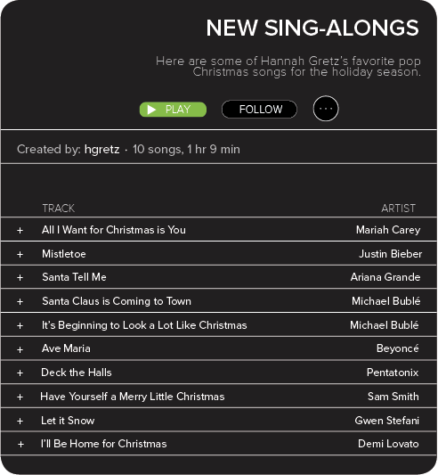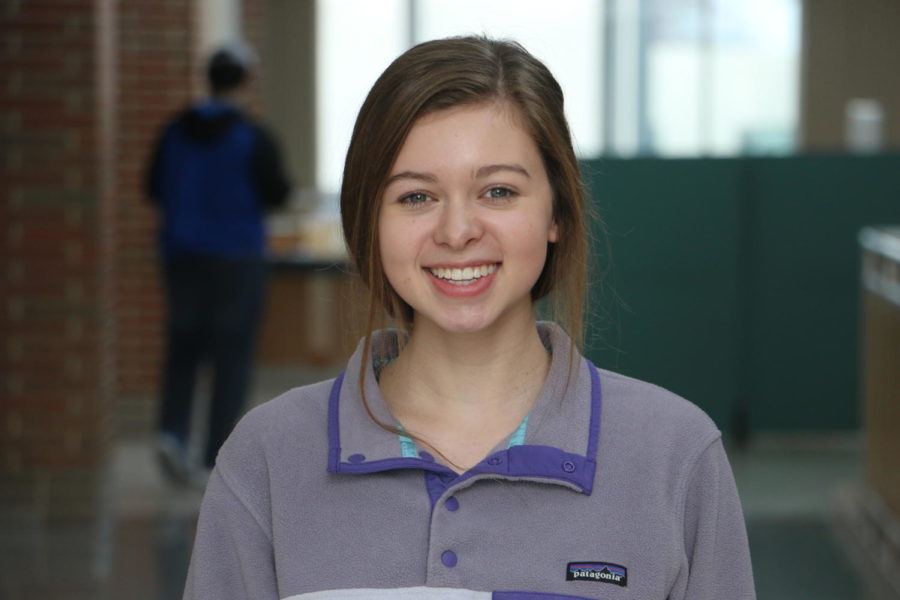From November to January, holiday music is and will be heard everywhere you go. Department stores, car radios, grocery stores, you name it. But, while classic holiday songs are festive and enjoyable, I cannot help but feel pulled toward pop-style holiday music instead.
Don’t get me wrong, I do often find myself enjoying the classics with family members during the holiday time, but some of my favorites are the pop-versions. I find it difficult not to bop along to “All I Want For Christmas Is You,” by Mariah Carey, “Santa Tell Me,” by Ariana Grande or “Mistletoe,” by Justin Bieber. With the engaging rhythm, approachable style, energetic and repetitive lyrics, pop music is irresistible to the ear during the fun-spirited holiday time.
From the past years, I have found that the pop-style holiday songs put me in a better, happier mood. With a more upbeat tune, it’s more enjoyable to listen to than to the originals. Many of the pop-style songs include instruments such as bass and electric, drum sets, guitars and piano, whereas classical music includes more instruments such as the cello, violin, saxophone, piano and trombone. Each of these instruments undoubtedly creates beautiful sounds, but a smile just happens to spread across my face wider when the instrumental pieces are more upbeat and perkier. Aside from that, artists such as Justin Bieber, Michael Bublé, Sia, Gwen Stefani, Ellie Goulding, Kelly Clarkson, Ariana Grande, Taylor Swift and more use their voices to turn the holiday music in a different direction, and I can easily find myself singing along to their pop-style holiday hits. Their holiday tracks are just that more appealing to me because I am already familiar with their award-winning pop music and have previously heard their voices before in the last couple of years.
According to a previous study conducted by Dr. Valorie Salimpoor, who is a researcher specializing in music enjoyment at McGill University, pop-style music has physical influences on those who listen to it. Salimpoor linked pop music with a surge in intense emotional arousal, including changes in heart rate, pulse, breathing rate and other measurements. When people listen to pop music, they have a pleasure trigger due to the faster and more upbeat rhythm. This further validates the idea that classical music is slower and less energetic compared to upbeat pop music.
I still very much enjoy sipping hot chocolate and listening to classic holiday music, but when I plug in my earbuds, I prefer my holiday playlist to consist of the pop-versions of popular holiday songs, rather than the classics.

The views in this column do not necessarily reflect the views of the HiLite staff. Reach Hannah Gretz at [email protected].
Read copy editor Jessica Konrad’s viewpoint on classical holiday music HERE.




























![Keep the New Gloves: Fighter Safety Is Non-Negotiable [opinion]](https://hilite.org/wp-content/uploads/2024/12/ufcglovescolumncover-1200x471.png)
















































![Review: “We Live in Time” leaves you wanting more [MUSE]](https://hilite.org/wp-content/uploads/2024/12/IMG_6358.jpg)
![Review: The premise of "Culinary Class Wars" is refreshingly unique and deserving of more attention [MUSE]](https://hilite.org/wp-content/uploads/2024/12/MUSE-class-wars-cover-2.png)
![Introducing: "The Muses Who Stole Christmas," a collection of reviews for you to follow through winter [MUSE]](https://hilite.org/wp-content/uploads/2024/12/winter-muse-4.gif)
![Review: "Meet Me Next Christmas" is a cheesy and predictable watch, but it was worth every minute [MUSE]](https://hilite.org/wp-content/uploads/2024/11/AAAAQVfRG2gwEuLhXTGm3856HuX2MTNs31Ok7fGgIVCoZbyeugVs1F4DZs-DgP0XadTDrnXHlbQo4DerjRXand9H1JKPM06cENmLl2RsINud2DMqIHzpXFS2n4zOkL3dr5m5i0nIVb3Cu3ataT_W2zGeDAJNd_E-1200x884.jpg)
![Review: "Gilmore Girls", the perfect fall show [MUSE]](https://hilite.org/wp-content/uploads/2024/11/gilmore-girls.png)
![Review in Print: Maripaz Villar brings a delightfully unique style to the world of WEBTOON [MUSE]](https://hilite.org/wp-content/uploads/2023/12/maripazcover-1200x960.jpg)
![Review: “The Sword of Kaigen” is a masterpiece [MUSE]](https://hilite.org/wp-content/uploads/2023/11/Screenshot-2023-11-26-201051.png)
![Review: Gateron Oil Kings, great linear switches, okay price [MUSE]](https://hilite.org/wp-content/uploads/2023/11/Screenshot-2023-11-26-200553.png)
![Review: “A Haunting in Venice” is a significant improvement from other Agatha Christie adaptations [MUSE]](https://hilite.org/wp-content/uploads/2023/11/e7ee2938a6d422669771bce6d8088521.jpg)
![Review: A Thanksgiving story from elementary school, still just as interesting [MUSE]](https://hilite.org/wp-content/uploads/2023/11/Screenshot-2023-11-26-195514-987x1200.png)
![Review: "When I Fly Towards You", cute, uplifting youth drama [MUSE]](https://hilite.org/wp-content/uploads/2023/09/When-I-Fly-Towards-You-Chinese-drama.png)
![Postcards from Muse: Hawaii Travel Diary [MUSE]](https://hilite.org/wp-content/uploads/2023/09/My-project-1-1200x1200.jpg)
![Review: "Ladybug & Cat Noir: The Movie," departure from original show [MUSE]](https://hilite.org/wp-content/uploads/2023/09/Ladybug__Cat_Noir_-_The_Movie_poster.jpg)
![Review in Print: "Hidden Love" is the cute, uplifting drama everyone needs [MUSE]](https://hilite.org/wp-content/uploads/2023/09/hiddenlovecover-e1693597208225-1030x1200.png)
![Review in Print: "Heartstopper" is the heartwarming queer romance we all need [MUSE]](https://hilite.org/wp-content/uploads/2023/08/museheartstoppercover-1200x654.png)




